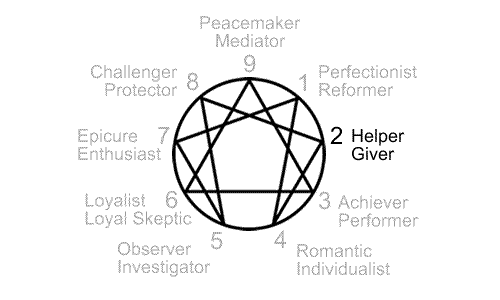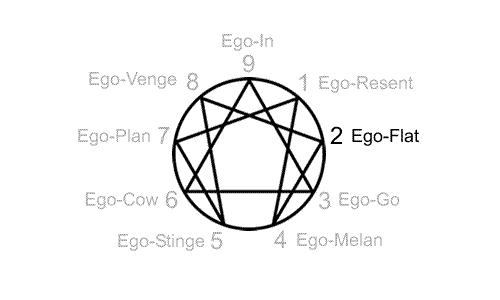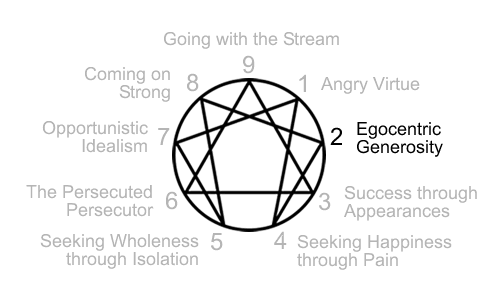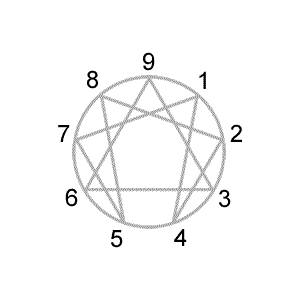Enneagram Type 2: Appreciation through Emotional Connection
The core focus of Enneagram type 2

Loneliness and the feeling of being unwanted is the most terrible poverty.
- Mother Teresa
Early in life we develop an initial belief about ourselves and a compensation for that self-belief.
-
Type 2 Initial Self-Belief: “I am unappreciated as I am.”
Type 2 Compensation: "I must find appreciation from and connection to people by responding to their needs and desires."
Over time this gets generalized beyond the self into a core focus that also shapes how we perceive and interact with the world at large.
-
Type 2 Core Focus: Appreciation comes from responding to the emotional needs and desires of others. This requires that I read their unspoken emotional cues in order to find a way to connect to and support them. From this I also find my role in the world and others' lives.
Personality characteristics that might arise from the type 2 core focus include:
- Represses own needs in service of others' needs
- Desires to be liked and important in the lives of others
- Shifts image to become what others desire or need
- Gets their own needs met by meeting the needs of others
- Emotionally seduces others to bring them closer
- Feels more comfortable giving than receiving
- Pays attention to emotional cues more than verbal content
- Thinks they know your needs better than you do yourself
- Unconsciously expects something in return for what they give
Enneagram author descriptions of type 2

Below are Enneagram type 2 description samplings from some popular or well-known Enneagram authors. Click on the sources after the descriptions to further explore these interpretations.
-
The Helper, The Caring, Interpersonal Type: Generous, Deomonstrative, People-Pleasing, and Possessive1
Basic Fear: Of being unloved and unwanted for themselves alone1
Basic Desire: To feel loved1
-
How Twos Pay Attention: Attention is by habit focused upon the emotional fluctuations of significant others, guided by the wish to become the object of their love.2
Basic Proposition: You gain love and approval, and fulfill your personal needs, through giving to others.2
Strengths: Caring, helpful, relationship-oriented, generous, sensitive to others’ feelings, supportive and exuberant2
Challenges: Prideful, dependent on approval of others, intrusive, demanding, entitled2
-
Energy goes into: Sensing the emotional needs of others and doing what pleases them. Feeling good about being able to meet others’ needs so well. Creating good feelings in others. Maintaining others’ acceptance and approval. Romantic attachment.3
-
The Helper: Warm, caring and giving, they are motivated by a need to be loved and needed, and to avoid acknowledging their own needs.4
-
Helpers are warm, concerned, nurturing, and sensitive to other people's needs.5
-
Focus of Attention: Twos focus on relationships, gaining approval, and seducing others through helpfulness as a strategic way to get their disowned needs met. Twos actively “read” the people around them and align with (what they perceive to be) their moods and preferences in order to maximize the potential for positive connection.6
Sources
1Book: The Wisdom of the Enneagram; Website: The Enneagram Institute
2Book: The Enneagram; Website: The Narrative Enneagram
3Book: The Essential Enneagram; Website: Dr. David Daniels
4Book: The Road Back to You
5Book: The Enneagram Made Easy
6Book: The Complete Enneagram; Website: Chestnut Paes Enneagram Academy
Type 2 Ego: Ego-Flat

The roots of the Enneagram types come from Oscar Ichazo's ego types. The ego types identified how a person was fixated in ego and the remedy for finding freedom from that.
Below are descriptions of Oscar Ichazo's ego type 2 fixation, trap, holy idea, passion, and virtue reinterpreted for today's Enneagram personality types.
Type 2 Fixation and Trap
Fixation: Flattery comes from praising and giving to others in order to connect to them and be liked or gain favor.
Trap: Freedom comes from being attentive to the needs and desires of others so they'll take care of yours.
The fixation of flattery points to the mental preoccupation of the type 2 ego. The trap of freedom keeps an individual stuck in the fixation.
Type 2 Holy Idea
Holy Idea: Holy Freedom is taking care of your own needs so that you can freely give to others without expecting anything in return.
The fixation of flattery and trap of freedom keep an individual stuck in the type 2 fixation. The way out of that fixation is through holy freedom.
Type 2 Passion
Passion: Pride is an inflated feeling of self-importance in the lives of others. "Others need me because I uniquely understand and can meet their needs and desires."
The passion of pride is the emotional energy that serves the fixation of flattery and trap of freedom.
Type 2 Virtue
Virtue: Humility appears when instead of seeking favored treatment and regard you accept that you are no more or less important than anyone else.
The virtue of humility is what appears when the passion of pride subsides.
Personality traits of Enneagram type 2

A psychiatrist named Claudio Naranjo evolved Oscar Ichazo's ego-types into the Enneagram personality types as we use them today. Naranjo largely based the types on Ichazo's passions.
Naranjo outlined the following trait structure for type 2 (Ennea-type II) in his books Ennea-type Structures and Character and Neurosis.
- Egocentric Generosity - Pride and Histrionism
- Pride
- Love Need
- Hedonism
- Seductiveness
- Assertiveness
- Nurturance and False Abundance
- Histrionism
- Impressionable Emotionality
Enneagram type 2 examples
While reading about the Enneagram types can be useful in understanding them, you eventually have to bring the types to life by seeing the many different ways they get expressed in life.
While the ideal is to be able to interact directly with people of each type, an alternative is to observe them from a distance. There are a number of ways to do this using videos. Many of these videos can be found on the Internet if you know what to look for (YouTube in particular).
- Type 2 Interviews and Self-Revelations
One method used to bring the types to life when teaching the Enneagram types involves interviewing people of a given type about how that type plays out in their life. This may be done through panels and one-on-one interviews.
Self-revelatory videos can also be useful where a person simply describes their type to a camera without the prompting of an interviewer.
Note that sometimes a person in a video may have been mistyped and may not offer an accurate representation of type when that happens.
- Type 2 Celebrities or Famous People
Once their Enneagram type is known, celebrities or famous people can also offer interesting examples of and insights into Enneagram type as revealed through interviews, lectures, writings, and the person's work.
However, it's not like the Enneagram panels, interviews, and self-revelations where people are specifically describing how they experience Enneagram type in their lives. It's more a matter of looking for glimpses into how Enneagram type is operating in the person.
It can be difficult to type someone at a distance. Look for a consensus of opinion on a person's type from multiple sources and hold it loosely. Celebrities and famous people are often typed differently by different Enneagram authors, teachers, and enthusiasts.
- Type 2 Fictional Characters
It needs to be made clear that fictional characters are not real people, even when they are based on real people. There can be a temptation to assign Enneagram type to every character in a story, but many characters don't have that kind of consistency or depth.
Not only might there be a number of different people, usually of different types, influencing the creation or portrayal of a character but often the character is nothing more than a vehicle for telling the story and moving it along.
While once in a while a character appears that you can attribute an Enneagram type to, generally it's more accurate to look at specific scenes as examples of a type rather than the character as a whole.
Tom Condon wrote a book called The Enneagram Movie & Video Guide that you may find useful for seeing type in fictional characters.
- Type 2 Songs and Lyrics
Although they do exist, there are few song lyrics that can be attributed to one particular Enneagram type. Most songs have both lyrical and musical elements that can be attributed to a number of different Enneagram types.
Songs are extremely subjective. There are many songs that listeners, and even performers, interpret in a very different way than the song writer intended. A number of songs also emphasize the sounds of words rather than their meaning.
As such, different people hearing the same song often will experience it as representing different Enneagram types.
Enneagram type 2 variations
There are a number of variations or flavors of type 2 that help explain why two people of the same type seem different. Click below for more info about variations of type 2.
Type 2 mistypes
Some people correctly identify their Enneagram type on their first try. For most other people determining type can take some time.
If you feel that you may have wrongly typed yourself as type 2 and have one or more alternative candidate types in mind then click on a link below to take a quick Enneagram test comparing type 2 to another type that may instead be your type.
Enneagram Tests to Help Determine Type

The Enneagram personality types consist of nine basic types. One of the types will be more dominant than the others. This dominant type is said to be "your Enneagram type".
Although there are nine basic Enneagram types, there are also many variations within each type as defined by such concepts as wings, centers, and instincts.
You can explore these variations using the type preference test below or one of the many other tests available on this website.
-
Enneagram Type Preference Test
This test produces a scored list of all nine types.
Questions are forced-choice, similar to the method used by the Riso-Hudson Enneagram Type Indictor (RHETI).
Use to determine type, wings, gut/heart/head types, and tri-center. -
Enneagram Type Comparison Test
This test compares any two types. The preferred type will have the higher score.
Use when you've narrowed your type down to two or three possibilities you'd like to compare.
Click here for the Complete Guide to the Enneagram.
This free guide explains- the nine Enneagram personality types
- the many type variations within type
- where the types came from (origins and history)
- how the types use the Enneagram symbol
Click here for Enneagram tests.
These free tests help you find your- primary type
- candidate types
- preferred wing
- intinctual subtype
- instinctual variant stacking
- center types (gut, heart, and head)
- tri-center with wings